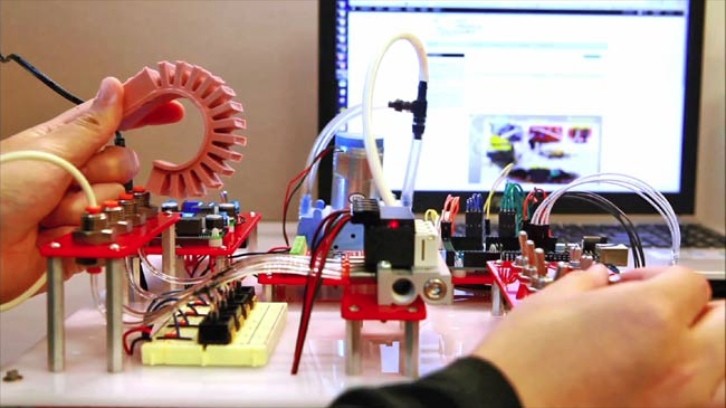Scientists from Harvard will not seize to surprise us. After they’ve recently unveiled their out-of-this-world soft robot, which is able squirm over fire, across ice and survive under a car tire, they now uploaded the entire toolkit any robot-maker needs on a website. In other words, any person that wants to create his own robot is able to do it with the push of a button. Almost.
A team of researchers led by Michael T. Tolley of the Harvard Microbotics Laboratory have recently created what could make for the world’s first untethered soft robot that is able to move around without rigid structural components. Using its flexible body, the robot moves around like a flailing starfish over all terrain. The flopping pink X robot has an optional electrical power tether, but can use a battery pack as well.
Like it wasn’t enough to make any geek out there drop his jaw, now Harvard tells us we can actually make one ourselves. Well, not really. Let us explain. A new resource unveiled today by researchers from several Harvard University labs in collaboration with Trinity College Dublin provides both experienced and aspiring researchers with what it needs to creat your own robot. It provides the intellectual raw materials needed to design, build and operate robots made from soft, flexible materials. How cool is that, right?
What are these people talking about, though? Well, using principles drawn from conventional rigid robot design, but working with pliable materials, engineers are pioneering the use of soft robotics for assisting in a wide variety of tasks. In other words, we might be looking at the prototypes that could stand for future robots used in physical therapy, minimally invasive surgery, and search-and-rescue operations in dangerous environments.
In case you mind, the Soft Robotics Toolkit is an online treasure trove of downloadable, open-source plans, how-to video, and case studies to assist users in the design, fabrication, modeling, characterization, and control of soft robotic devices. Harvard claims it will provide researchers with a level of detail not typically found in academic research papers, including 3D models, bills of materials, raw experimental data, multimedia step-by-step tutorials, and case studies of various soft robot designs. In case you need more, just watch the video below.
So, what will your robot look like?
Like it wasn’t enough to make any geek out there drop his jaw, now Harvard tells us we can actually make one ourselves. Well, not really. Let us explain. A new resource unveiled today by researchers from several Harvard University labs in collaboration with Trinity College Dublin provides both experienced and aspiring researchers with what it needs to creat your own robot. It provides the intellectual raw materials needed to design, build and operate robots made from soft, flexible materials. How cool is that, right?
What are these people talking about, though? Well, using principles drawn from conventional rigid robot design, but working with pliable materials, engineers are pioneering the use of soft robotics for assisting in a wide variety of tasks. In other words, we might be looking at the prototypes that could stand for future robots used in physical therapy, minimally invasive surgery, and search-and-rescue operations in dangerous environments.
In case you mind, the Soft Robotics Toolkit is an online treasure trove of downloadable, open-source plans, how-to video, and case studies to assist users in the design, fabrication, modeling, characterization, and control of soft robotic devices. Harvard claims it will provide researchers with a level of detail not typically found in academic research papers, including 3D models, bills of materials, raw experimental data, multimedia step-by-step tutorials, and case studies of various soft robot designs. In case you need more, just watch the video below.
So, what will your robot look like?

